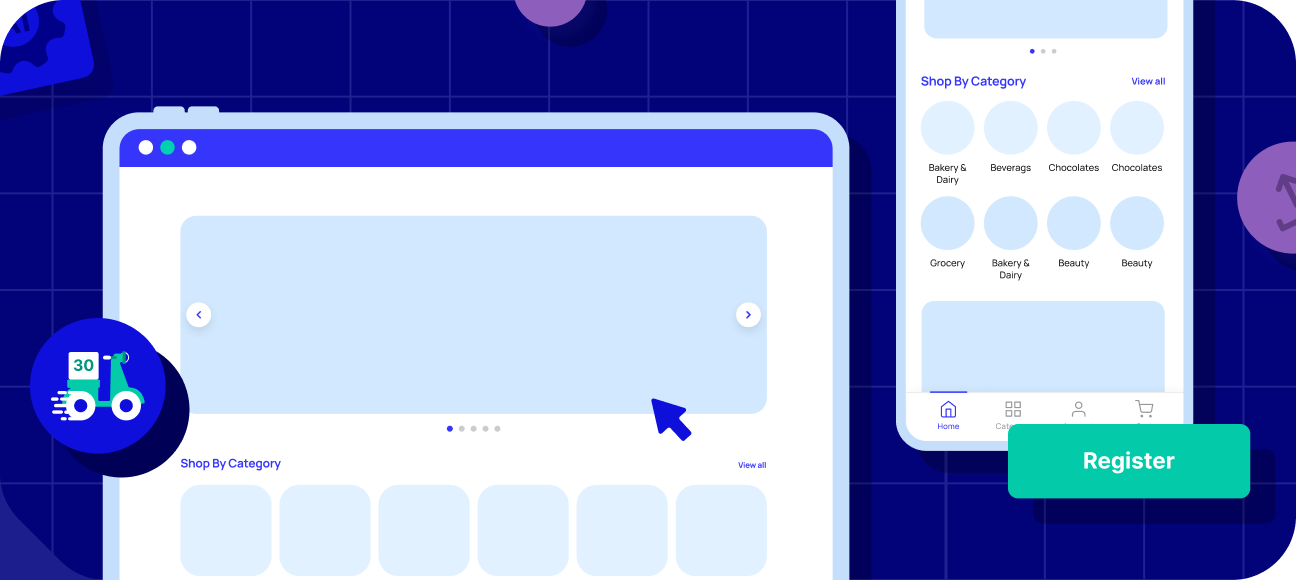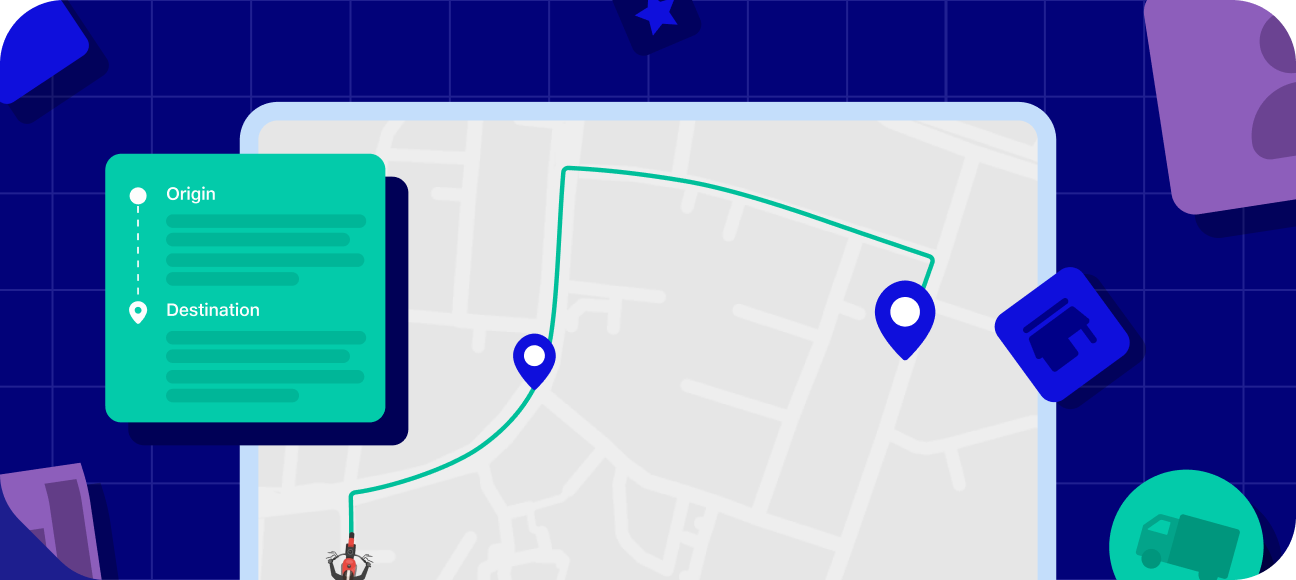Solutions for every business need
Growth comes in all shapes and sizes. Whether it’s smoother operations, sharper insights, higher revenue—or all of the above—we’ve got you covered

Warehouse management made simple
Gain full control over your inventory with smart automation, real-time tracking, and efficient workflows—ensuring your stock moves smoothly, every time

Launch hyperlocal commerce instantly
Set up and scale your hyper-local e-commerce with easy tools for web, orders, and delivery management—bringing you closer to customers, faster

Delivery management made easy
Gain control over your deliveries with real-time visibility, smart automation, and seamless coordination—ensuring on-time arrivals, every time

Order management made easy
Master every order with full visibility, smart automation, and effortless control—delivering the right outcomes, every time

Speak to an expert
Explore how Fynd Commerce can improve every aspect of your business, from online to instore and beyond

Speak to an expert
Explore how Fynd WMS powers operational excellence with our solution experts

Speak to an expert
Explore how Fynd Quick powers hyperlocal businesses with our solution experts

Speak to an expert
Explore how Fynd TMS powers better deliveries with our solution experts

Speak to an expert
Explore how Fynd OMS powers seamless order management with our solution experts

Featured Blog


Empower your business, every step of the way
Simplify operations, scale smarter, and deliver better experiences with solutions designed to grow with your business
Take your warehouse management to the next level
Experience hassle-free inventory management with Fynd WMS, designed to keep your operations efficient and accurate. Book a demo to see how Fynd WMS can boost productivity and profits for your business!
Kickstart your quick delivery website
Experience seamless hyper-local commerce with Fynd Quick—engineered to keep things running smoothly and help you reach customers in record time. Book a demo and see how Fynd Quick can drive efficiency and growth for your business!
Level up your delivery management
See how you can manage deliveries with Fynd TMS, designed to streamline operations and keep your customers delighted. Book a demo with our team and find out how Fynd TMS can boost your efficiency and bottom line!
Take your order management to the next level
Discover how effortless order management can be with Fynd OMS, built to keep things running smoothly and make your customers happy. Book a demo with our team and see how Fynd OMS can help boost your efficiency and profits!
The future is already here! Everything that used to be imagined ten years ago is in customers' hands today, and they are taking good advantage of it by shopping & experiencing products on the move. Retailers are now focused on implementing innovative technologies that will improve the customer experience and stay competitive.
The fight to distinguish retail business offerings on digital and physical channels together (An immersive phygital experience) is driving the race to better customer shopping experience, brand loyalty, and service.
Here are some remarkable retail technology trends in 2023 adopted by retail businesses worldwide.
Trend 1: Augmented Reality for Consumers

Augmented Reality is the new retail business norm in 2023. Enhanced in-store navigation experiences, AR live stream shopping, virtual fitting rooms are spreading across the industry in no time.
American Eagle is a leading global specialty retailer offering high-quality, on-trend clothing, accessories, and personal care products at affordable prices under its American Eagle® and Aerie® brands. It ran a back-to-school 2021 campaign: “Future Together, Jeans Forever” featuring new styles for teenagers.
As part of the promotion, the company worked with Snapchat to develop an augmented reality "dress yourself" experience that allows users to shop for and try on selected ensembles using their self-facing camera. The commercial starred a cast of teenage actors and promoted a digital apparel line for Bitmoji avatars.
Kohl’s Virtual Closet
Click, click, click and check out! As many consumers continue to shop from home, Kohl's is continuing to lean into the convenience of our digital channels, like Kohls.com and the Kohl’s App.
Kohl's recently partnered with Snapchat to create the Kohl's Augmented Reality (AR) Virtual Closet, allowing users to shop for their favourite styles from a curated selection of Kohl's merchandise. When users discover a look they like, they may purchase it directly from the Snapchat app. Kohl's Snapchat Virtual Closet initially featured spring fashions and then expanded to include athletic and athleisure goods as buyers sought comfortable work-from-home clothing during the COVID-19 pandemic.
Trend 2: Artificial Intelligence in the Retail Industry

Inventory management powered by AI
AI can be used in inventory management and other valuable consumer behavior analysis.
The complexity of computer systems and databases has resulted in many inefficiencies from errors. Artificial intelligence can assist us in managing these inventories more successfully in a variety of ways. For instance, AI can analyze consumer spending data to forecast when specific types of merchandise are expected to move more quickly on the sales floor. It can cause the system to prioritize particular areas for human auditing over others. While inspecting the entire business area presents a significant challenge, checking only the areas that require priority care is far more effective.
When it comes to Amazon Go Grocery stores powered by Just Walk Out, the company takes it a step further. This project uses deep learning, sensor fusion, and computer vision. The store's extensive network of cameras and IoT sensors can recognize when a customer removes an item from the shelf and places it in their shopping basket. When a customer leaves the store, the store will automatically charge their credit card for the purchased products.
It requires a deep understanding of the customer's products in their basket and a thorough knowledge of the Amazon retail store's layout. Even if an item is moved away from its original location on the shelf, the retailer must keep track of it.
Consumer behaviour analysis
Retail businesses can use artificial intelligence to measure their spending habits and consumers' interest in spending money alongside their demographics. It can give companies a better idea of how they should be marketing to their audiences.
The powerful AI technology can track the user's behavior while visiting an online storefront. It can reveal some exciting information about a customer shopping, like what items their cursor hovers over, how much time they spend on a particular page, and where they come from.
Trend 3: Indoor Positioning System

The global indoor positioning and indoor navigation market was valued at $2,642 million in 2017 and is projected to reach $43,511 million by 2025, growing at a CAGR of 42.0% from 2018 to 2025.
The usage of Indoor Positioning Systems (IPS) has been a growing trend for a few years now, allowing users to navigate around indoor environments where GPS is either unavailable or insufficiently reliable.
Target has implemented Bluetooth IoT lighting systems at many of its locations. When customers shop in-store using the Target app on their phone, they gain access to a map that assists them in locating their location within the store and locating the items they require. These are some great ways in which Target is using them to better customer shopping experience.
Use in item tracking: The placement of products on the sales floor may be more accurately tracked using IPS. As a result, not only will the protection of assets be enhanced, but it will also be made more accessible to return moved things to their correct locations.
Share targeted deals: When customers use the retail store’s official app to locate themselves in a particular store area, the IPS system may track their location and provide them with the targeted product and discount suggestions on their smartphone. IPS systems are becoming increasingly popular as they can help to increase conversions when customers shop.
Trend 4: Smart Omnichannel Shopping Baskets

Smart shopping baskets allow your customers to add, edit or check out products from every physical and digital brand channel. To enhance the customer experience further, retailers have started integrating omnichannel customer profiles. These profiles are updated with each new interaction and are available to customers and sales employees at all touchpoints.
Customers may access their shopping carts and profiles from any of the brand's touchpoints.
- Retailers have a better chance of closing a deal.
- Retailers gain a complete understanding of their customers, which can be used for retargeting purposes.
Kroger is the latest retailer to test connected shopping carts in the age of social distancing. The wireless carts can total your purchases, give recommendations, and accept payment immediately on the cart. The gadgets eliminate the need to queue alongside strangers or pass stuff off to a salesperson. The AI company claims that smart carts encourage customers to spend more money because they can keep track of their purchases in real-time and provide them with more marketing materials while they shop. For example, if you purchase cereal, it may also recommend that you buy milk.
Trend 5: Retail Brands Using Metaverse

The Metaverse is the joining of physical and digital worlds. Here is a list of brands and their campaigns in Metaverse.
Nike: A non-fungible token studio that creates digital collectibles (including digital sneakers) to integrate culture and gaming was acquired by Nike in December 2021. Real sneakers matched with virtual ones were sold by RTFKT and juvenile artist FEWOCiOUS for $3.1 million in less than six minutes, selling 600 pairs and NFTs in total.
A recent trademark filing indicates that Nike intends to develop and sell virtual footwear, apparel, and accessories branded with the Nike logo that may be used in virtual settings.
Gucci: In connection with the launch of Garden Archetypes, an immersive multimedia experience, Gucci collaborated with Roblox to create Gucci Garden, an interactive virtual exhibit. As guests entered the Gucci Garden, their avatars transformed into neutral mannequins. Each visitor's mannequin absorbs elements of the exhibition as they move through the various rooms. With each person encountering the rooms in a unique order and retaining pieces of the spaces, they emerge as one-of-a-kind creations at the end of their journey.
Conclusion
In this blog, we took a look at some of the top retail technology trends for 2023. We hope you've enjoyed this article and found it helpful to your understanding of the advancements in the retail industry. Some of the trends are already in use, while some are expected to become standard by 2022. Retail stores have already started to use AI, AR, IPS, smart baskets, while some companies plan to use them later this year. So, these trends are already happening and will become common by 2022.
Fynd is India's largest omnichannel platform trusted by over 600 brands and 10,000 stores helping retail businesses accelerate growth and adapt to dynamically changing retail technologies. Integrate now to grow and manage multiple sales channels seamlessly. Book a Demo or Contact us today to learn more about our industry-recognized & future-proof omnichannel solutions for the retail industry.
Frequently asked questions
The top 5 retail technology trends that will define 2023 are augmented reality for consumers, artificial intelligence in the retail industry, indoor positioning systems, omnichannel retailing, and robotics.
Augmented reality is being used in the retail industry in various ways, such as enhancing in-store navigation experiences, AR live stream shopping, and virtual fitting rooms. Retailers like American Eagle and Kohl's have already started using augmented reality to offer unique shopping experiences to their customers.
Artificial intelligence is helping the retail industry in several ways, including inventory management, consumer behavior analysis, and customer service. AI can analyze consumer spending data to forecast when specific types of merchandise are expected to move quickly on the sales floor and can help companies understand how to market their products to their target audience.
An indoor positioning system (IPS) is a technology that allows users to navigate around indoor environments where GPS is either unavailable or insufficiently reliable. Retailers like Target are using Bluetooth IoT lighting systems and IPS to help customers locate products within their stores and to track the placement of products on the sales floor more accurately.
Omnichannel retailing is a retailing approach that aims to provide a seamless shopping experience to customers across all channels, both physical and digital. Retailers that use omnichannel retailing strategies can offer their customers a consistent and personalized shopping experience regardless of the channel they use to shop.
Robotics is being used in the retail industry to automate certain tasks such as product sorting, stock counting, and shelf-stocking. Robotics can help retailers save time and improve efficiency, allowing them to focus on providing excellent customer service and improving the overall shopping experience.

%20(1).webp)


%2520(1).webp)
.webp)




